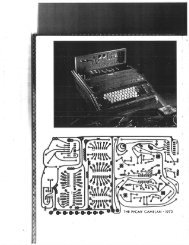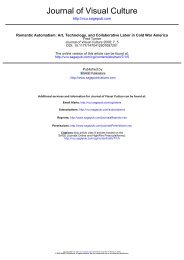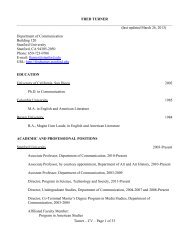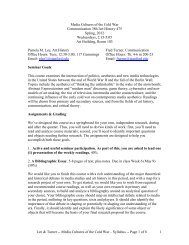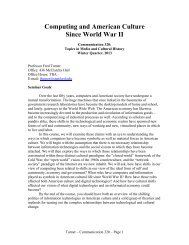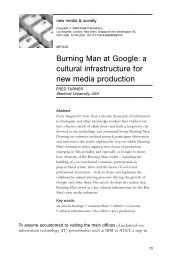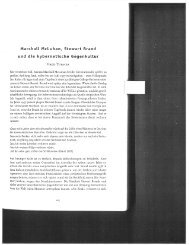The Family of Man and the Politics of Attention in ... - Public Culture
The Family of Man and the Politics of Attention in ... - Public Culture
The Family of Man and the Politics of Attention in ... - Public Culture
You also want an ePaper? Increase the reach of your titles
YUMPU automatically turns print PDFs into web optimized ePapers that Google loves.
<strong>Public</strong> <strong>Culture</strong><br />
field <strong>of</strong> vision technique developed by Bayer <strong>and</strong> deploy<strong>in</strong>g it <strong>in</strong> a new political<br />
context. With images literally all around <strong>the</strong>m, visitors to <strong>The</strong> <strong>Family</strong> <strong>of</strong> <strong>Man</strong> had<br />
to make choices about where to look <strong>and</strong> how to <strong>in</strong>tegrate what <strong>the</strong>y saw <strong>in</strong>to <strong>the</strong>ir<br />
own worldviews. This process <strong>in</strong> turn exercised <strong>the</strong> psychological muscles on<br />
which democracy <strong>and</strong> perhaps even <strong>the</strong> future <strong>of</strong> <strong>the</strong> world depended.<br />
In 1955 a number <strong>of</strong> reviewers marveled at <strong>the</strong> show’s <strong>in</strong>stallation <strong>and</strong> its implications<br />
for viewers. One reviewer, photographer Barbara Morgan, even argued that<br />
<strong>the</strong> comb<strong>in</strong>ation <strong>of</strong> architectural <strong>and</strong> photographic elements <strong>in</strong> <strong>the</strong> show constituted<br />
a new medium: “Here one is <strong>in</strong>stantly conscious that this is no orthodox show <strong>of</strong><br />
‘exhibition pr<strong>in</strong>ts’ hung salon- wise. It is someth<strong>in</strong>g for which we need a new term. . . .<br />
Several have been suggested, ‘photographic- Mosaic,’ ‘three- dimensional editorializ<strong>in</strong>g,’<br />
‘movie <strong>of</strong> stills,’ yet <strong>the</strong>y all fail — too cumbersome — not accurate enough.” 40<br />
Morgan went on to select her own term, <strong>the</strong> “<strong>the</strong>me show,” <strong>and</strong> to describe it as a<br />
new “photographic genre . . . which fuses science, photography, architecture, layout<br />
<strong>and</strong> writ<strong>in</strong>g <strong>in</strong>to a compell<strong>in</strong>g syn<strong>the</strong>sis.” Above all, this new genre forced <strong>in</strong>dividuals<br />
to develop <strong>in</strong>dependent psychological reactions to what <strong>the</strong>y saw: “[<strong>The</strong>]<br />
juxtaposition <strong>of</strong> photographs meant to be seen <strong>in</strong> relation to each o<strong>the</strong>r begets new<br />
mean<strong>in</strong>g to a thoughtful visitor. . . . Our bl<strong>in</strong>d spots <strong>and</strong> sensitivities be<strong>in</strong>g semantically<br />
what <strong>the</strong>y are, to every th<strong>in</strong>k<strong>in</strong>g onlooker <strong>the</strong>se cross- connected ways <strong>of</strong> life<br />
will mean vastly different th<strong>in</strong>gs.” Yet <strong>the</strong>y would not lead to an unlimited range <strong>of</strong><br />
<strong>in</strong>terpretation. Ra<strong>the</strong>r, <strong>the</strong>y would lead to a diverse but unified condition <strong>of</strong> <strong>in</strong>terpersonal<br />
<strong>and</strong> <strong>in</strong>ternational empathy. As Morgan put it,<br />
40. Barbara Morgan, “<strong>The</strong> <strong>The</strong>me Show: A Contemporary Exhibition Technique,” <strong>in</strong> n.a., “<strong>The</strong><br />
Controversial <strong>Family</strong> <strong>of</strong> <strong>Man</strong>,” Aperture 3, no. 2 (1955): 24.<br />
41. Morgan, “<strong>The</strong>me Show,” 26.<br />
82<br />
In comprehend<strong>in</strong>g <strong>the</strong> show <strong>the</strong> <strong>in</strong>dividual himself is also enlarged, for<br />
<strong>the</strong>se photographs are not photographs only — <strong>the</strong>y are also phantom<br />
images <strong>of</strong> our co- citizens; this woman <strong>in</strong>to whose photographic eyes I now<br />
look is perhaps today weed<strong>in</strong>g her family rice paddy, or boil<strong>in</strong>g a fish <strong>in</strong><br />
coconut milk. Can you look at <strong>the</strong> polygamist family group <strong>and</strong> imag<strong>in</strong>e<br />
<strong>the</strong> different norms that make <strong>the</strong>m live happily <strong>in</strong> <strong>the</strong>ir society which is<br />
so unlike — yet like — our own? Empathy with <strong>the</strong>se hundreds <strong>of</strong> human<br />
be<strong>in</strong>gs truly exp<strong>and</strong>s our sense <strong>of</strong> values. 41<br />
Conclusion<br />
Over <strong>the</strong> next decade, <strong>the</strong> images that made up <strong>The</strong> <strong>Family</strong> <strong>of</strong> <strong>Man</strong> would be<br />
repackaged <strong>in</strong>to books <strong>and</strong> portable exhibitions. <strong>The</strong>y would be separated from



